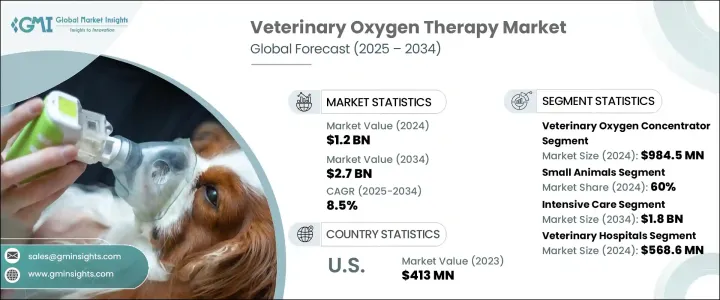
세계의 동물용 산소 요법 시장은 2024년 12억 달러로 평가되었고 CAGR 8.5%를 나타내 2034년에는 27억 달러에 이를 것으로 추정되고 있습니다. 반려동물의 건강에 대한 의식 증가, 반려동물의 인간화, 고급 치료 솔루션에 대한 주인의 지출 의욕 증가가 동물 의료 현장에서의 산소 요법의 채용을 강화하고 있습니다. 성 폐색성 폐질환(COPD) 및 기타 호흡기 합병증과 같은 증상은 특히 오염 수준이 높은 도시 환경에서 점점 더 흔해지고 있습니다. 동물용 산소 요법은 수술 후 회복과 심각한 케어를 위한 신뢰할 수 있는 방법으로 대두해 왔습니다. 덧붙여 비만과 관련된 합병증 증가나 반려동물의 고령화에 의해 진료소나 가정에서의 지속적·긴급적인 산소 요법에 대한 수요가 가속하고 있습니다.

현재 동물병원이나 전문클리닉 중에는 생존율 향상과 치료성적 개선을 목적으로 농축기, 비강 카테터, 고효율 산소마스크 등의 고도의 산소요법기기를 도입하는 곳이 늘어나고 있습니다. 이러한 산소 농축기는 연속적인 산소 유량을 제공하기 때문에 특히 만성적인 증상에 대해서는 진료소내와 집에서의 케어의 양쪽 모두에 이상적입니다. 기존의 산소 봄베에 비해, 휴대형 산소 농축기는 지속가능성이 높고, 유지관리도 적게 유지하기 때문에 개업
| 시장 범위 | |
|---|---|
| 시작 연도 | 2024년 |
| 예측 연도 | 2025-2034년 |
| 시작 금액 | 12억 달러 |
| 예측 금액 | 27억 달러 |
| CAGR | 8.5% |
시장은 제품 유형별로 동물용 산소농축기와 액세서리로 구분됩니다. 고령의 반려동물은 폐렴, 기관지염, 호흡 곤란 증후군 등의 질병에 걸리는 경우가 많아, 그 치료에는 산소 요법이 바람직합니다.
동물유형별로 보면, 시장은 소동물과 대동물로 분류되며, 2024년 점유율은 작은 동물이 60%를 차지했습니다. 북미에서는 강력한 반려동물 건강 관리 인프라, 높은 반려동물 사육률, 만성 호흡기 질환에 대한 인식이 높아짐에 따라 동물용 산소 요법 시장은 2024년 세계 점유율의 39.9%를 차지했습니다.
Imex Medical Limited, AEOLUS International Pet Products, Drive DeVilbiss International, Koninklijke Philips, Vetland Medical, RWD Life Science, Airnetic, Shinova Systems, BMW Animal Technology, Longfian Scitech등의 주요 기업이 시장 전망을 형성하고 있습니다. 이러한 기업은 기술 혁신을 우선해, 보다 휴대용으로 비용 효과가 높고, 효율적인 산소 요법 시스템을 도입하기 위해서 연구 개발에 다액의 투자를 실시했습니다.
The Global Veterinary Oxygen Therapy Market was valued at USD 1.2 billion in 2024 and is estimated to grow at a CAGR of 8.5% to reach USD 2.7 billion by 2034. This growth trend reflects a significant transformation in veterinary healthcare as oxygen therapy becomes a core component in treating pets with respiratory disorders and chronic illnesses. Rising awareness about pet health, the humanization of pets, and increased willingness among pet owners to spend on advanced treatment solutions are reinforcing the adoption of oxygen therapy across veterinary settings. Conditions like pneumonia, asthma, chronic obstructive pulmonary disease (COPD), and other respiratory complications are becoming increasingly common, especially in urban environments where pollution levels are high. Veterinary care is undergoing a shift toward more patient-friendly, non-invasive solutions, with oxygen therapy emerging as a reliable method for post-surgical recovery and critical care. In addition to that, the rising prevalence of obesity-related complications and aging pet populations are accelerating the demand for continuous and emergency oxygen support in clinics and at home.

A growing number of veterinary hospitals and specialty clinics are now incorporating advanced oxygen therapy devices such as concentrators, nasal catheters, and high-efficiency oxygen masks to improve survival rates and enhance treatment outcomes. Post-operative complications often require oxygen therapy for stabilized recovery, making it a critical part of intensive veterinary care. Technological innovations, especially the introduction of portable oxygen concentrators, have significantly improved care delivery. These devices offer continuous oxygen flow, making them ideal for both in-clinic and at-home care, particularly for chronic conditions. Compared to traditional oxygen cylinders, portable concentrators are more sustainable and require less maintenance, offering cost-effective solutions for both practitioners and pet owners.
| Market Scope | |
|---|---|
| Start Year | 2024 |
| Forecast Year | 2025-2034 |
| Start Value | $1.2 Billion |
| Forecast Value | $2.7 Billion |
| CAGR | 8.5% |
The market is segmented by product type into veterinary oxygen concentrators and accessories. The oxygen concentrator segment alone generated USD 984.5 million in 2024. This includes both stationary and portable devices, which are being increasingly used due to a rise in surgical interventions and emergency respiratory cases. Aging pets often suffer from ailments such as pneumonia, bronchitis, and respiratory distress syndrome, for which oxygen therapy is the preferred method of care. The convenience, efficiency, and eco-friendliness of concentrators have made them a preferred choice among veterinary professionals.
By animal type, the market is categorized into small and large animals, with the small animal segment accounting for a 60% share in 2024. This dominance is linked to the widespread ownership of small pets like pugs, bulldogs, and Persian cats, which are prone to breathing disorders. In North America, the veterinary oxygen therapy market accounted for 39.9% of the global share in 2024, thanks to strong pet healthcare infrastructure, higher pet ownership rates, and growing awareness of chronic respiratory conditions.
Leading companies such as Imex Medical Limited, AEOLUS International Pet Products, Drive DeVilbiss International, Koninklijke Philips, Vetland Medical, RWD Life Science, Airnetic, Shinova Systems, BMV Animal Technology, and Longfian Scitech are shaping the market landscape. These players are prioritizing innovation and investing heavily in research and development to introduce more portable, cost-effective, and efficient oxygen therapy systems. They are also forming strategic alliances with veterinary hospitals and clinics to enhance their service networks and launching cutting-edge devices to address the evolving needs of veterinary care.